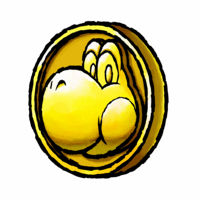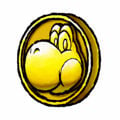Coin: Difference between revisions
(organizing images) |
McQueenMario (talk | contribs) |
||
| Line 38: | Line 38: | ||
Image:SM64DS_YellowCoin.jpg|Yellow Coin with a Star stamp from ''[[Super Mario 64]]'' | Image:SM64DS_YellowCoin.jpg|Yellow Coin with a Star stamp from ''[[Super Mario 64]]'' | ||
Image:Coinsmg.jpg|Mario collecting Coins | Image:Coinsmg.jpg|Mario collecting Coins | ||
Image:Smscoin.jpg| | Image:Smscoin.jpg|''[[Super Mario Sunshine]]'' | ||
Image:NSMBwii coin.jpg|''[[New Super Mario Bros. Wii]]'' | Image:NSMBwii coin.jpg|''[[New Super Mario Bros. Wii]]'' | ||
</gallery> | </gallery> | ||
Revision as of 09:45, November 18, 2009
Coins (sometimes known as Gold Coins or Yellow Coins, and also called Mushroom Coins in the Beanbean Kingdom and Koopabits in the Nintendo Comics System stories) are the main currency of the Mushroom Kingdom. They first appeared in Mario Bros., where they moved along the floor and were worth one hundred points if Mario or Luigi caught them. They later appeared in Super Mario Bros., where they were demoted to ten points per coin. If Mario jumped up and hit a ? Block, sometimes Coins would pop out. When one hundred Coins were collected, the player was rewarded with an extra life. Coins served the same function in Super Mario Bros.: The Lost Levels, Super Mario Bros. 3, New Super Mario Bros. and New Super Mario Bros. Wii
In Super Mario Bros. 2, Coins could only be retrieved by using a Magic Potion to create a door near unpicked Vegetables. When this door appeared, the Mario, Luigi, Toadstool, or Toad could use it to travel to Subspace and pick out the aforementioned Vegetables, who would then be extra point-rewarding Coins. In the Mario Party series, these Coins are used to buy Stars, Items, and Orbs. They are usually obtained by winning a mini-game, when using Orbs, or at the start of the game. The way the Coins look dramatically changes with each game since Mario Party.
In Super Mario Kart, Coins were found at each course. Collecting them would make karts faster. When jostling another driver or getting hit by an item such as a Red or Green Shell, the player would lose Coins. Jostling a driver without having any Coins would result in sliding. There was even an item providing the player with two extra Coins. Mario Kart Super Circuit had the same things as Super Mario Kart, but without the extra-coin item.
In Mario is Missing!, Luigi had to return coins to the Trevi Fountain in Rome which were stolen by Koopa Troopas. Legend says that whoever throws coins into the fountain will return to Rome one day. When Luigi returned the coins, he was rewarded $1500.
In Yoshi's Island and its sequel, Coins would give an extra life for every hundred collected. Super Paper Mario explains that Coins came from the Sammer Guy warrior Footsteps of Coins, who is the one who purposely drops coins around the universe. The coins are his, and despite dropping them in bizarre places, he doesn't want anybody else to take them.In the Paper Mario series, Coins are fairly common. Coins will appear whenever an enemy is defeated. However, when Mario runs away from a battle, he will lose coins. However, not only do Coins come from usual ? Blocks, but they come from trees and bushes Mario could find in various places. To get a single coin from a tree, Mario has to use his Hammer to make the tree shake so that the single coin would fall down. To find the single coin in a bush, Mario simply tried to search a bush when he went near one.
Mario & Luigi: Superstar Saga introduces regular coins and Beanbean Coins. Prince Peasley made a bet of 99,999,999,999,999 Mushroom Kingdom Coins with Mario and Luigi, about who should find the pieces of the Beanstar first. Mario and Luigi win, and Prince Peasley rewards them with the promised coins. However, since they were Mushroom Kingdom Coins, the exchange rate translated into only 99 Beanbean coins. In Super Smash Bros. Melee, a Coin appears as a trophy, although this trophy (which is labeled "Gold Coin") appears to be depicting a Yellow Coin from Super Mario 64. This game also introduces Smash Coins.
Other Coins
Super Mario World introduced the Dragon Coin, a special Coin that could only be found in certain places. Usually there were only five in each level. Coins had a very important role in Super Mario Land 2: Six Golden Coins. Six Golden Coins were actually the key to Mario's Castle, and Wario had scattered these Coins across Mario Land. Each Golden Coin was guarded by a different creature; Ricky, Radonkel, Sabasa, Tatanga, the Three Little Pigheads, and an Octopus were all guardians of the Coins. Regular Coins could also be used to buy extra lives and power-ups through a gambling minigame whose stats could be changed depending on how many Coins were spent.
Super Mario World 2: Yoshi's Island also introduced Red Coins, which were disguised as regular Coins until Yoshi touched them. Super Mario 64 introduced Blue Coins and Yellow Coins, two more different types of coins, and every normal Coin it featured was actually a Star-imprinted Yellow Coin. Super Mario Sunshine followed the same formula as Super Mario 64, although it featured normal, classic Coins rather than Yellow Coins. Super Mario Advance introduced a new type of giant, red coin called the Ace Coins. Regular coins could also be found, although they were harder to find (and, as was in the original Super Mario Bros. 2, could only be found in Subspace).
Coins were the most common treasure in Luigi's Mansion. They were worth 5000 G, and could be found all over the mansion. Whenever Luigi took damage, he would lose a few Coins, which would disappear if they were not reclaimed quickly enough. In New Super Mario Bros., a Star Coin could be found in any level (there are three in each level). If Mario or Luigi collects five Star Coins, he can unlock Mushroom Houses. Twenty Star Coins are required to get a new background for the touch screen, purchasable in the Blue Mushroom House. (In order to unlock the Blue Mushroom House, the final level (W8-Green Castle) must be completed.)
Super Mario Galaxy introduced new coins called Purple Coins. In some of the missions in the game, Mario or Luigi needs to collect 100 Purple Coins in order to obtain a Power Star. They are scattered all over the galaxy and sometimes have a time limit to collect them all. Regular Coins also appeared, but they were far rarer in this game than in any other Mario game to date. Mostly relegated to being a way to restore Mario's health, they were largely replaced by Star Bits. Collecting fifty in a single stage still awarded Mario with a 1-Up, however.
Trophy Information
| File:Trophy153.PNG | The Mushroom Kingdom is dotted with these mysterious coins. There seems to be an endless supply hidden in various blocks, and Mario gains an extra life when he manages to collect a hundred of them. No one can confirm whether or not these coins are actually used as the currency of the Mushroom Kingdom, but it's a safe assumption. |
Gallery
- Coin.jpg
- SM64DS YellowCoin.jpg
Yellow Coin with a Star stamp from Super Mario 64
- Coinsmg.jpg
Mario collecting Coins
- Smscoin.jpg
- NSMBwii coin.jpg
Trivia
- There has been much controversy over the correct capitalization of the word "Coin"; most games use the proper "Coin" in reference to the Coin as an item but simply use "coin" when using it to label prices. As such, most games interchangeably use both "Coin" and "coin" depending on usage.
- In Super Mario Land 2: Six Golden Coins, a glitch existed that could turn Mario into a variety of sprites; these sprites included all frames of a Coin's animation, effectively allowing the player to control a Coin.
- A Sammer Guy named Footsteps of Coins claims that it is he who hides the coins around each game.
- In Luigi's Mansion, the crown of King Boo was equal in value to one Gold Coin (5000 G).
Template:Super Mario Bros.
Template:Super Mario Bros. 3
Template:Yoshi's Island DS
Template:Hotel Mario
| Super Mario Land | |
|---|---|
| Protagonists | Mario • Princess Daisy |
| Bosses | King Totomesu • Dragonzamasu (Tamao) • Hiyoihoi • Biokinton (Chicken) • Tatanga (Pagosu) |
| Locations | Sarasaland (Birabuto Kingdom • Muda Kingdom • Easton Kingdom • Chai Kingdom) |
| Levels | World 1-1 • World 1-2 • World 1-3 • World 2-1 • World 2-2 • World 2-3 • World 3-1 • World 3-2 • World 3-3 • World 4-1 • World 4-2 • World 4-3 • Expert Level |
| Items & vehicles | Super Mushroom • Superball Flower • Star • 1UP heart • Coin • Marine Pop • Sky Pop • Switch • Lift Block |
| Enemies & obstacles | Batadon • Bombshell Koopa • Bullet Biff • Bunbun • Chikako • Dropping lift • Falling block • Falling spike • Fly • Ganchan • Gao • Gunion • Goombo • Honen • Kumo • Mekabon • Nyololin • Pionpi • Pipe Fist • Piranha Plant • Pompon Flower • Roketon • Roto Disc • Suu • Tokotoko • Torion • Yurarin • Yurarin Boo |
| Other | Brick • Bonus game • Das Super Mario Spiel • Gallery • Glitches • Goal • Media • Mystery Block • Soundtrack |
| Wario Land: Super Mario Land 3 | |||
|---|---|---|---|
| Characters | Wario • Brown Sugar Pirates • Mario | ||
| Bosses | Spiked Koopa • Minotaur • Penguin • Devil's Head • Bobo • Ghost • Captain Syrup • Genie | ||
| Worlds | Rice Beach • Mt. Teapot • Sherbet Land • Stove Canyon • SS Tea Cup • Parsley Woods • Syrup Castle | ||
| Power-ups | Bull Pot • Dragon Pot • Garlic Pot • Jet Pot • Star | ||
| Collectibles | ? Block • 1 Gold Coin • 10 Gold Coin • 100 Coin • 3-Up Heart • Heart • Key • Treasure | ||
| Enemies and obstacles | Batto Shuruken • Bee Fly • Big • Bō • Bucket Head • Chicken Duck • D.D. • Demon Bat • Dropper • Floater • Gaugau • Goboten • Guragura • Harisu • Helmut • Knight • Konotako • Kōmori Missile • Lance • Maizō • Mine • Muncher • Paidan • Pecan • Penkoon • Pikkarikun • Pinwheel • Piranha Plant • Pirate Goom • Pouncer • Skewer • Sparky • Spiked ball • Togemaru • Ukiwani • Wanderin' Goom • Watch • White puff • Yadorā • Yarikuri Obake | ||
| Miscellaneous | Gallery • Glitches • Media • Pre-release and unused content • Staff | ||
Template:WW may refer to...
- Template:Wario World, covering Wario World.
- Template:Wario's Woods, covering Wario's Woods.
| This is a disambiguation page — a list of pages that otherwise might share the same title. Please follow one of the disambiguation links above or search to find the page you were looking for if it is not listed. If an article link referred you here, you might want to go back and fix it to point directly to the intended page. |
Template:The Super Mario Bros. Super Show! Animated Template:The Adventures of Super Mario Bros. 3 Template:Super Mario World TV


